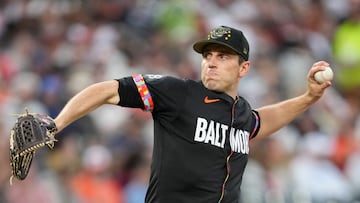MLB
Orioles lose John Means and Tyler Wells for the season as relentless pursuit of speed decimates arms
The Baltimore Orioles face a significant setback in their rotation with the loss of two key pitchers, John Means and Tyler Wells to UCL repair surgery.

The Baltimore Orioles are climbing a steep hill as their rotation loses not one but two key components as both John Means and Tyler Wells are to undergo UCL repair surgery.
John Means, the Orioles’ ace, was expected to be a cornerstone of the team’s rotation. Unfortunately, he suffered a severe elbow injury that required Tommy John surgery, effectively sidelining him for the entire season. This injury not only impacts the current season but also raises concerns about his availability and effectiveness in the future, as the recovery process for such a surgery can be lengthy and unpredictable.
Tyler Wells, another promising pitcher for the Orioles, also saw his season cut short due to health issues. Wells, who had transitioned successfully from the bullpen to the starting rotation, was showing great promise with his consistent performances. However, a series of injuries, including shoulder inflammation, led to the difficult decision to shut him down for the rest of the year. This decision, while prudent for his long-term health, leaves a significant gap in the Orioles’ pitching staff, compounding the challenges faced by the team.
The loss of Means and Wells puts considerable pressure on the Orioles’ remaining pitchers and the organization’s depth. The team will now have to rely more heavily on less experienced players or those who have yet to prove themselves at the major league level. This situation could affect the Orioles’ competitive edge in the highly challenging American League East division, where they face tough opponents like the New York Yankees, Boston Red Sox, and Tampa Bay Rays. The pitching staff’s instability may lead to a greater burden on the offense to produce runs, increasing the overall strain on the team.
The pursuit of higher pitching speeds has become a prevalent trend in Major League Baseball, driven by the desire to overpower hitters and achieve more strikeouts. This emphasis on velocity has led to pitchers routinely throwing fastballs exceeding 95 miles per hour. While this strategy has its advantages, it places considerable stress on pitchers’ arms, particularly their elbows and shoulders. The repetitive high-speed motions required to consistently deliver such pitches increase the risk of severe injuries, including torn ligaments and rotator cuff issues, often necessitating surgeries like Tommy John.
Pitchers today are also pushing the boundaries of their physical capabilities with enhanced training regimes focused on increasing velocity. These training methods often include weightlifting, resistance training, and specialized throwing programs designed to boost arm speed. However, the aggressive nature of these programs can exacerbate the wear and tear on a pitcher’s arm. The combination of high-intensity throwing and rigorous physical conditioning can lead to overuse injuries, as the arm’s muscles, tendons, and ligaments may not adequately recover between games and practice sessions.
The growing list of injured pitchers in MLB suggests that the league may need to reevaluate its approach to pitching development and training. While the allure of high velocity is undeniable, a balance must be struck to ensure pitchers can sustain long, healthy careers. This could involve modifications to training programs, more emphasis on mechanics and control, and perhaps even changes to pitching workloads. By prioritizing the long-term health of pitchers over short-term gains in velocity, MLB can help reduce the incidence of severe arm injuries and maintain the overall quality and excitement of the game.
Looking ahead, the Orioles’ management will need to navigate these challenges carefully, possibly considering trades, free-agent signings, or accelerated development of their minor league prospects to fill the void left by Means and Wells. This season’s setbacks might also prompt a reassessment of the team’s long-term strategy, focusing on building a more resilient roster that can withstand such unexpected losses. Despite the current adversity, the Orioles can use this opportunity to develop younger talent and potentially unearth new stars who can contribute significantly in future seasons.






